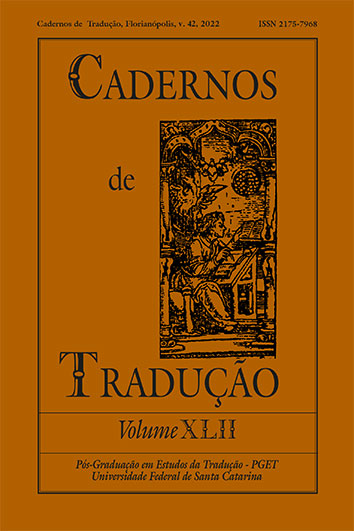Domesticating vs. foreignizing positions in the translation of proper names from English into Polish and German
DOI:
https://doi.org/10.5007/2175-7968.2022.e86083Schlagworte:
proper names, translation strategies, domestication, foreignization, Harry PotterAbstract
In this paper, the author examines corresponding equivalents in Polish and German of English proper names from the novel “Harry Potter and the Philosopher’s Stone” to find out how the same fictional elements have been translated into two different target languages. Furthermore, he attempts to prove what rules can be established for the use of translation strategies when translating proper names into Polish and German. Thus, the aim of this paper is to study domesticating and foreignizing translation strategies implemented by the translators of the Polish and German editions.
Literaturhinweise
Primary literature:
Rowling, Joanne Kathleen. Harry Potter and the Philosopher’s Stone. London: Bloomsbury Children’s Books, 2014.
Rowling, Joanne Kathleen. Harry Potter i kamień filozoficzny. Translated by Andrzej Polkowski. Poznań: Media Rodzina, 2000.
Rowling, Joanne Kathleen. Harry Potter und der Stein der Weisen. Translated by Klaus Fritz. Hamburg: Carlsen, 2018.
Secondary literature:
Baker, Mona. In other words: A coursebook on translation. London: Routledge, 2003.
Buć, Bartosz. “A no-tendency tendency. Proper names in polish translation: An analytical study on the basis of the Harry Potter series”. Applied Linguistics Papers 25/4, p. 15-25, 2018.
Burkhanov, Igor. Translation: Theoretical prerequisities. Rzeszów: Wydawnictwo Uniwersytetu Rzeszowskiego, 2003.
Cambridge Online Dictionary. Available at: https://dictionary.cambridge.org/dictionary/english/fluffy Accessed in: Jan. 31, 2018.
Debus, Friedhelm. “Eigennamen in der literarischen Übersetzung”. In: Glase, Elvira & Schlaefer Mona & Rübekeil Ludwig (Eds.). Grammatica Ianua Artium: Festschrift für Rolf Bergmann zum 60. Geburtstag. Heidelberg: Universitätsverlag Winter, 1997. p. 394-405.
Fernández Guerra, Ana. “Translating culture: problems, strategies and practical realities”. [sic] – a Journal of literature, culture and literary translation, No. 1 Year 3, p.1-28, 2012. DOI: https://www.sic-journal.org/ArticleView.aspx?aid=173
Hejwowski, Krzysztof. Translation: A cognitive-communicative approach. Olecko: Wydawnictwo Wszechnicy Mazurskiej, 2004.
Hengst, Karlheinz. “Wege der Poetonomastik”. In: Brendler Andrea & Brendler Silvio (Eds.). Namenforschung morgen. Ideen, Perspektiven, Visionen. Hamburg: Baar, 2005. p. 81-86.
Hrehovčík, Teodor. Introduction to translation. Rzeszów: Wydawnictwo Uniwersytetu Rzeszowskiego, 2006.
Jäger, Gert & Jäger, Sonja “Zum Problem der Namen beim Übersetzen aus dem Deutschen ins Spanische”. Fremdsprachen, 131/134, p. 108-114, 1969.
Kalverkämper, Harald. Textlinguistik der Eigennamen. Stuttgart: Klett-Cotta, 1978.
Kohlheim, Volker. “Proper names in literature: A reevaluation of all values”. Onoma: Journal of the International Council of Onomastic Sciences, 53, p. 81-92, 2018.
Kromp, Ilona. Eigennamen in der deutschen und polnischen Kinderliteratur unter textlinguistischem und translatorischem Aspekt. Frankfurt am Main: Peter Lang, 2008.
Krüger, Dietlind. “Eigennamen in der literarischen Übersetzung, dargestellt am Beispiel von Übersetzungen von J.K. Rowlings Harry Potter”. NI, 85/86, p. 141-163, 2004.
Newmark, Peter. Approaches to translation. Oxford: Pergamon Press, 1982.
Nida, Eugene. Toward a science of translating. Leiden: E.J. Brill, 1964.
Nord, Christiane. Text analysis in translation: Theory, methodology, and didactic application of a model for translation-oriented text analysis. Amsterdam: Rodopi, 2005.
Piotrowska, Maria. Learning translation – Learning the impossible? A course of translation from English into Polish. Kraków: Universitas, 2010.
Pym, Anthony & Turk, Horst. “Translatability”. In: Baker Mona. (Ed.). Routledge Encyclopaedia of translation studies. New York: Routledge, 2001. p. 273-277.
Schleiermacher, Friedrich. “[Über die verschiedenen] Methoden des Übersetzens”. In: Störig Hans Joachim (Ed.). Das Problem des Übersetzens. Darmstadt: Wissenschaftliche Buchgesellschaft, 1963, p. 38–70.
Schwarz, Narcisa & Stiegelbauer, Laura-Rebeca & Husar, Diana-Bianca. “Translation problems and difficulties in applied translation processes”. Studii de ştiinţă şi cultură. 2016. Available at: https://www.researchgate.net/publication/315528028_Translation_Problems_and_Difficulties_in_Applied_Translation_Processes Accessed in Dec. 14, 2021.
Tomedes. Available at: https://www.tomedes.com/translator-hub/most-translated-author.php Accessed in: Jan. 19, 2020.
Vendler, Zeno. “Singular terms”. In: Steinberg Danny & Jakobovich Leon (Eds.). Semantics. Cambridge: Cambridge University Press, 1975. p. 115-133.
Venuti, Lawrence. “Strategies of translation”. In: Baker Mona (Ed.). Routledge Encyclopaedia of translation studies. New York: Routledge, 2001. p. 240-244.
Vermes, Albert. “On the translation of proper names”. Eger journal of English studies, I, 1996. p. 179-189.
Wizarding World. Available at: https://www.wizardingworld.com/news/500-million-harry-potter-books-have-now-been-sold-worldwide Accessed in: Jan. 19, 2020.
Downloads
Veröffentlicht
Zitationsvorschlag
Ausgabe
Rubrik
Lizenz
Copyright (c) 2022 Cadernos de Tradução

Dieses Werk steht unter der Lizenz Creative Commons Namensnennung 4.0 International.
Autores têm autorização para assumir contratos adicionais separadamente, para distribuição não exclusiva da versão do trabalho publicada nesta revista (ex.: publicar em repositório institucional ou como capítulo de livro, com reconhecimento de autoria e publicação inicial nesta revista).





















































